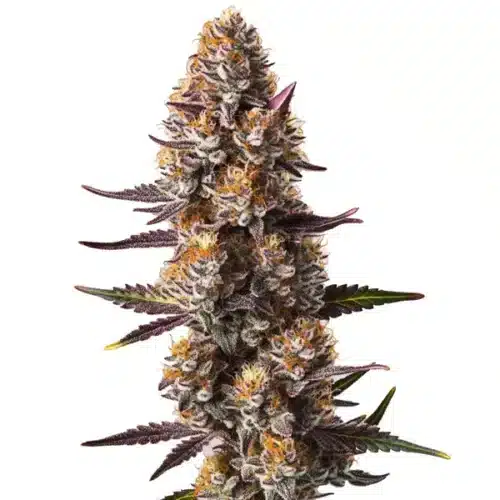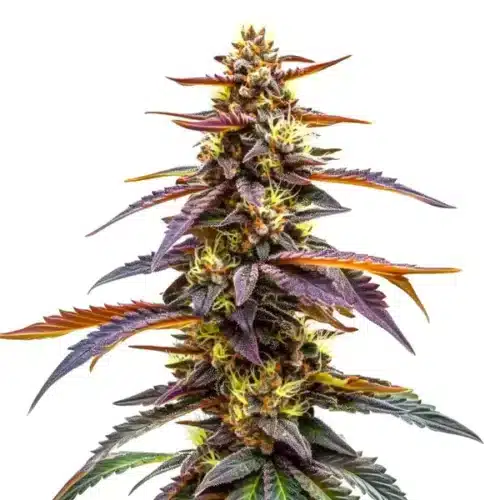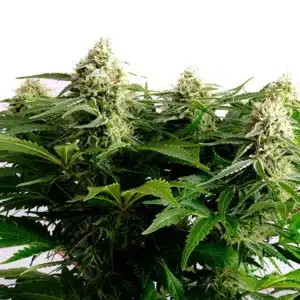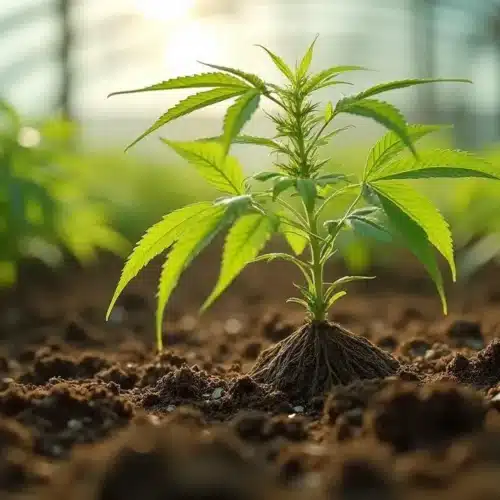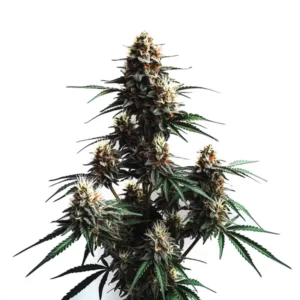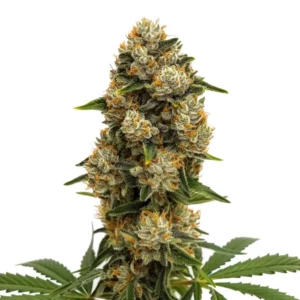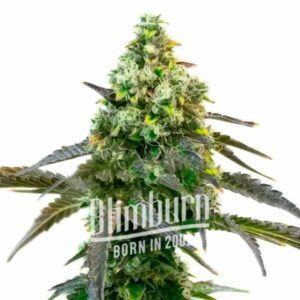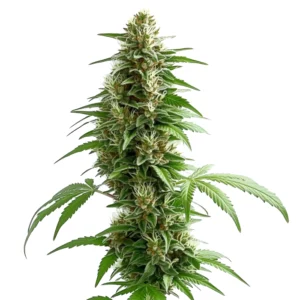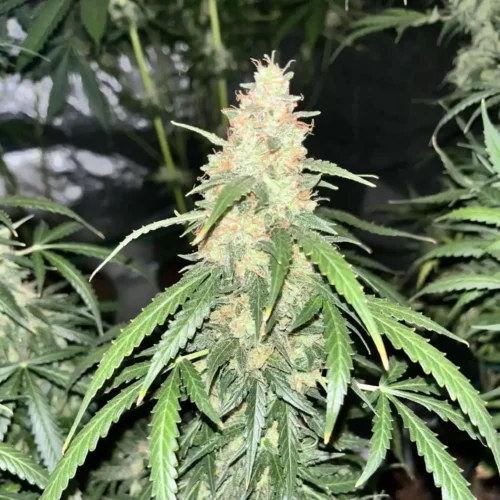Discover the unique world of Cannabis Ruderalis, a lesser-known member of the cannabis family with potential that stretches beyond its wild origins.
Cannabis Ruderalis, and its unique ruderalis seeds, often fly under the radar, yet the ruderalis marijuana plant offers attributes that go beyond autoflowering and resilience. This unassuming plant, with its distinct characteristics and capabilities, holds a unique position within the cannabis genus. Its resilience, auto-flowering traits, and unique chemical profile make it an intriguing subject for researchers, cultivators, and consumers alike. In this comprehensive exploration, we delve into the world of Cannabis Ruderalis, shedding light on its origins, unique features, cultivation practices, and its evolving role in medical and recreational cannabis markets.
Recommended Strains
Rude Boy OG
 THC: 25% - 28%
THC: 25% - 28% Type of seed: Feminized
Type of seed: Feminized Phenotype: Mostly Indica
Phenotype: Mostly Indica Day to flower: 8 - 10 weeks
Day to flower: 8 - 10 weeks
RudeBoi OG F1
 THC: 19% - 23%
THC: 19% - 23% Type of seed: Feminized F1
Type of seed: Feminized F1 Phenotype: Mostly Hybrid
Phenotype: Mostly Hybrid Day to flower: 8 - 10 weeks
Day to flower: 8 - 10 weeks
What is Cannabis Ruderalis?
Cannabis Ruderalis, often regarded as the third type of cannabis alongside Sativa and Indica, stands out for its unique qualities and adaptability. This cannabis species is native to Central Asia and Eastern Europe, particularly thriving in Russia and Mongolia. What sets Ruderalis apart is its remarkable resilience and ability to flourish in the harsh, unpredictable climates of its native lands. Unlike its cousins, which require careful control of light exposure to flower, Ruderalis is characterized by its auto-flowering trait, meaning it will flower based on its age rather than the light cycle it’s exposed to.
The stature of Cannabis Ruderalis is another distinctive feature; it is typically smaller and more compact than both Sativa and Indica plants. This modest size is an adaptation to its natural environment, where wind and low temperatures prevail. Ruderalis plants usually grow between 20 to 25 inches tall, making them the shortest of the cannabis types. This size attribute, coupled with its auto-flowering capability, has made Ruderalis increasingly popular among cultivators looking for strains that can be harvested quickly and can adapt to various growing conditions.
In terms of chemical composition, Cannabis Ruderalis has a lower THC (Tetrahydrocannabinol) content than both Sativa and Indica, which are known for their psychoactive properties. However, it often has a higher CBD (Cannabidiol) content, which has attracted significant interest for its potential medical benefits, including pain relief, anti-anxiety effects, and seizure reduction without the psychoactive high associated with higher THC strains. This makes Ruderalis a valuable plant for researchers and medical cannabis producers aiming to develop strains that can deliver therapeutic benefits.
Despite its less prominent status in the cannabis world, Ruderalis’s genetics have become a key component in the development of hybrid strains. By crossbreeding Ruderalis with Sativa and Indica varieties, breeders can produce strains that combine the desirable psychoactive effects of Sativa and Indica with the hardiness and auto-flowering traits of Ruderalis. These hybrids can offer the best of both worlds: the ability to flower automatically, making them easier to grow, and the medicinal or recreational effects users seek.
Promos & Deals
Comparing Ruderalis with Sativa and Indica
The cannabis plant, with its diverse strains and varieties, presents a fascinating study in adaptation, utility, and cultural significance. At the heart of this diversity are three primary types: Sativa, Indica, and Ruderalis. Each has unique characteristics shaped by their origins, environmental adaptations, and human cultivation practices. The distinctions between Cannabis Ruderalis and its more famous counterparts, Sativa and Indica, is crucial for appreciating the complexity and richness of the cannabis genus.
Genetic Heritage and Physical Characteristics
Cannabis Sativa and Indica have long been recognized for their psychoactive properties, cultivated by humans for thousands of years for medical, recreational, and industrial purposes. Sativa strains, originating from equatorial regions, are known for their tall stature, narrow leaves, and longer flowering cycles, adapted to the lengthy sunny days of their native climates. Indica strains, hailing from the Hindu Kush region of the Middle East, are characterized by their shorter, bushier growth, broader leaves, and quicker flowering times, suited to the cooler, mountainous conditions.
In contrast, Cannabis Ruderalis is the wild card of the cannabis family. Emerging from the harsh environments of Central Asia and Eastern Europe, Ruderalis is naturally smaller and more robust, with a thick stem and broad leaves, albeit fewer in number. Its stature is diminutive compared to its cousins, rarely exceeding two feet in height, a direct adaptation to its harsh, unpredictable environment.
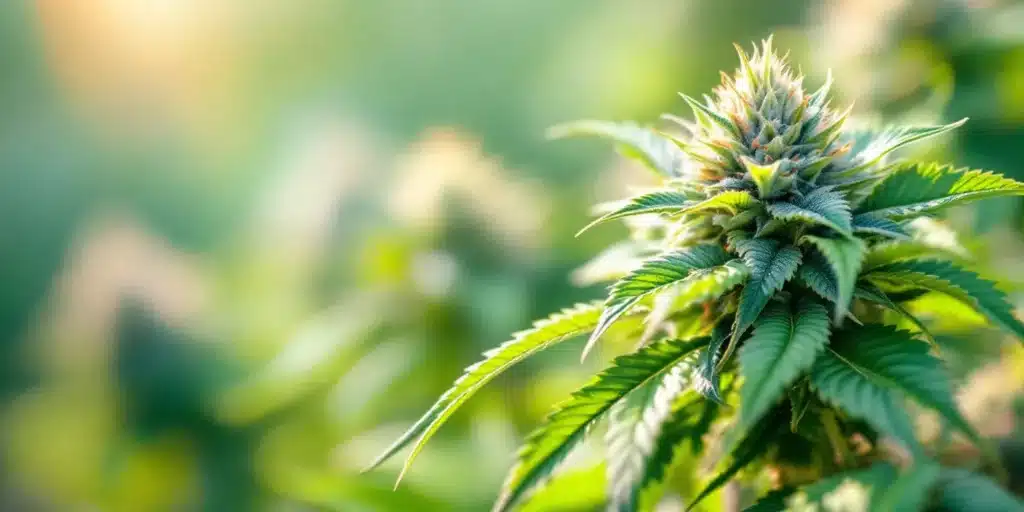
Flowering Cycles: The Ruderalis Distinction
The most striking difference between Ruderalis and the other cannabis types lies in their flowering cycles. Sativa and Indica varieties are photoperiod-dependent, meaning they require specific light conditions to transition from the vegetative stage to flowering. This trait aligns with human cultivation needs but is less suited to the unpredictable light conditions of the wild.
Ruderalis, however, is an auto-flowering plant. It does not depend on light changes to begin its flowering process. Instead, Ruderalis plants automatically initiate flowering based on age, a significant advantage in their native lands where daylight hours can vary dramatically. This auto-flowering trait has made Ruderalis invaluable in the creation of hybrid strains, allowing for more flexible and efficient cultivation practices.
Chemical Profiles: THC and CBD Content
Another critical area of comparison is the chemical composition of these plants, particularly their THC (Tetrahydrocannabinol) and CBD (Cannabidiol) levels. Sativa and Indica strains have been selectively bred over centuries to increase their THC content, the primary psychoactive component responsible for the ‘high’ associated with cannabis use. Sativas are often associated with a more cerebral, energizing high, while Indicas are known for their sedative effects.
Ruderalis, on the other hand, contains relatively low levels of THC but higher levels of CBD, a compound with numerous reported health benefits but without the psychoactive effects of THC. This makes Ruderalis strains particularly appealing for medical applications, offering therapeutic benefits without the intoxication associated with higher THC strains.

Cultivation and Utility
The cultivation practices and utility of these cannabis types further highlight their differences. Sativa and Indica strains require more controlled environments, with careful attention to light cycles for optimal yield. They are prized for their potent flowers, used both recreationally and medicinally.
Ruderalis’s resilience and auto-flowering capability make it a robust candidate for harsh climates and novice growers. Its genetic contributions to hybrid strains have revolutionized cannabis cultivation, allowing for the development of strains that combine the best traits of all three types: the resilience and auto-flowering of Ruderalis, with the desirable psychoactive and therapeutic effects of Sativas and Indicas.
Unique Characteristics of Cannabis Ruderalis
Cannabis Ruderalis, often overshadowed by its more popular relatives, Cannabis Sativa and Indica, harbors a suite of unique characteristics that distinguish it within the cannabis family. These traits not only reflect its evolutionary adaptability but also its burgeoning significance in the realms of cultivation and medical research. Exploring the cannabis ruderalis characteristics offers insights into its resilience, genetic makeup, and potential applications, shedding light on a plant that is much more than a mere curiosity.

Auto-flowering: A Defining Trait
One of the most defining features of Cannabis Ruderalis is its auto-flowering capability. Unlike Sativa and Indica strains, which require changes in light exposure to trigger the flowering phase, Ruderalis plants automatically initiate this process after a certain period of vegetative growth, regardless of the light cycle. This remarkable trait is an evolutionary adaptation to the harsh, unpredictable climates of its native regions, where daylight hours can vary significantly. Auto-flowering enables Ruderalis to complete its lifecycle efficiently, ensuring its survival and reproduction within short growing seasons.
Robustness and Resilience
Cannabis Ruderalis exhibits an inherent robustness, enabling it to thrive in less-than-ideal environmental conditions. Its origin in the challenging climates of Central Asia and Eastern Europe has equipped Ruderalis with a resilience to temperature fluctuations, poor soil quality, and physical disturbances. This hardiness makes it an attractive option for cultivators dealing with harsh growing conditions or looking to minimize the care required for plant cultivation.
Compact Size and Rapid Growth Cycle
The physical stature of Cannabis Ruderalis is another distinctive feature. It typically grows to a modest height, rarely exceeding two feet, making it much smaller than its Sativa and Indica counterparts. This compact size is accompanied by a rapid growth cycle, allowing Ruderalis plants to progress from seed to harvest in as little as 10 weeks. These characteristics make Ruderalis particularly suitable for indoor cultivation or in areas with limited space, providing an efficient option for growers operating on a smaller scale or with time constraints.
Chemical Composition: High CBD, Low THC
Perhaps the most impactful characteristic of Cannabis Ruderalis from a medicinal perspective is its chemical composition. Ruderalis strains generally have a lower THC (Tetrahydrocannabinol) content than Sativa and Indica strains but are higher in CBD (Cannabidiol). THC is the psychoactive compound that produces the “high” associated with cannabis, while CBD is non-psychoactive and has been studied for its potential therapeutic effects, including pain relief, anti-anxiety, and anti-inflammatory properties. The higher CBD and lower THC levels make Ruderalis particularly appealing for medicinal use, offering health benefits without the psychoactive effects.
Genetic Contributions to Hybrid Strains
The unique genetic traits of Cannabis Ruderalis have not gone unnoticed by cultivators and breeders. Its auto-flowering and resilient nature have been leveraged through crossbreeding with Sativa and Indica strains to produce hybrid varieties that embody the best of all worlds. These hybrids can offer the psychoactive and medicinal benefits of Sativa and Indica strains while inheriting the auto-flowering, robustness, and compact growth characteristics of Ruderalis, unlike the traits found in pure ruderalis seeds. This genetic contribution has expanded the possibilities for cannabis cultivation, enabling the development of strains tailored to a wide range of climates, growing conditions, and medical applications.
Cultivation and Uses of Cannabis Ruderalis
Cannabis Ruderalis, often overshadowed by its more popular relatives, Sativa and Indica, possesses unique traits that make it a subject of increasing interest among cultivators and consumers. Its distinct characteristics not only influence how it is grown but also how it can be used, offering a blend of opportunities that extend beyond traditional cannabis cultivation and consumption paradigms.
Cultivation: Embracing the Auto-flowering Advantage
The cultivation of Cannabis Ruderalis introduces a set of advantages primarily centered around its auto-flowering nature. Unlike Sativa and Indica strains, which require carefully controlled light cycles to transition from vegetative growth to flowering, Ruderalis plants automatically begin to flower based on age. This auto-flowering trait significantly simplifies the cultivation process, making it an attractive option for both novice gardeners and experienced cultivators looking for a more straightforward growth cycle.
Adaptability and Resilience
Ruderalis’s origins in harsh climates have imbued it with a level of resilience not found in its cannabis counterparts. It can thrive in conditions that would challenge other strains, from cooler northern latitudes to the variable environments of indoor grows. This robustness makes Ruderalis-based hybrids particularly suited for outdoor cultivation in a wide range of climates, reducing the need for extensive environmental control and making it an eco-friendly choice for sustainable cultivation practices.
Growth Cycle Efficiency
The relatively short growth cycle of Ruderalis, from seed to harvest, allows for multiple growing cycles within a single season. This efficiency can increase productivity for commercial cultivators and provide continuous harvests for personal growers. Additionally, its compact size makes it suitable for small spaces, an ideal trait for indoor cultivation where space is often at a premium.
Uses of Cannabis Ruderalis: Beyond Recreation
While Ruderalis lacks the high THC content associated with recreational cannabis use, its rich CBD profile opens up a plethora of medical and therapeutic applications. CBD is celebrated for its potential health benefits, including pain relief, anti-inflammatory properties, and anxiety reduction, without the psychoactive effects of THC. Ruderalis strains are thus particularly valuable for patients seeking the medicinal benefits of cannabis without the high.
Hybridization and Genetic Contributions
Perhaps the most significant use of Cannabis Ruderalis lies in its contribution to the development of hybrid cannabis strains. By crossbreeding Ruderalis with Sativa and Indica varieties, cultivators have created strains that combine the desirable psychoactive or therapeutic effects of THC and CBD with the auto-flowering and resilient traits of Ruderalis. These hybrids offer the best of both worlds: the potency and medical benefits of traditional cannabis with the easy-to-grow, adaptable nature of Ruderalis.
FAQs about Cannabis Ruderalis
How does Cannabis Ruderalis differ from Sativa and Indica?
Cannabis Ruderalis differs significantly from Sativa and Indica in several key areas:
- Growth Habit: Ruderalis is known for its auto-flowering trait, meaning it flowers based on the plant’s age rather than the light cycle. This is in contrast to Sativa and Indica, which are photoperiod-dependent.
- Size: Ruderalis plants are generally smaller and more robust, making them well-suited for harsh climates.
- THC and CBD Content: Ruderalis typically has a lower THC content and a higher CBD content compared to Sativa and Indica, which are often sought after for their high THC levels.
What are the auto-flowering characteristics of Ruderalis?
Auto-flowering in Cannabis Ruderalis refers to the plant’s ability to automatically switch from the vegetative stage to the flowering stage without the need for a change in light duration. This trait is genetically programmed and occurs after the plant reaches a certain age, usually a few weeks after germination. This characteristic is particularly valuable for breeding, allowing for the development of auto-flowering hybrid strains that can flower without the strict light regimen required by pure Sativa and Indica strains.
Can Ruderalis be used for medical purposes?
Yes, Cannabis Ruderalis can be used for medical purposes, primarily due to its high CBD content. CBD, or cannabidiol, is a compound found in cannabis that has been studied for its potential to relieve pain, reduce anxiety and depression, and offer anti-inflammatory properties, among other health benefits. Unlike THC, CBD does not produce psychoactive effects, making Ruderalis and its hybrids popular choices for patients looking for symptom relief without the high associated with THC-dominant strains.
How do you cultivate Cannabis Ruderalis?
Cultivating Cannabis Ruderalis is relatively straightforward due to its hardy nature and auto-flowering characteristic. It does not require changes in light cycles to flower, making it an ideal choice for beginners or for outdoor growing in climates where controlling light exposure is challenging. Basic cannabis cultivation practices apply, including providing adequate water, ensuring good soil drainage and nutrition, and protecting plants from pests and diseases. Its resilience and quick growth cycle also allow for multiple harvests in a single growing season in some climates.
What future prospects does Ruderalis hold in the cannabis industry?
The future prospects for Cannabis Ruderalis in the cannabis industry are promising, particularly in the development of auto-flowering and CBD-rich hybrid strains. Its genetic traits are increasingly harnessed to create hybrids that combine the desirable psychoactive effects of Sativa and Indica with the robust, easy-to-grow characteristics of Ruderalis. Additionally, as the medical cannabis market continues to expand, the demand for high-CBD, low-THC strains is likely to increase, highlighting the importance of Ruderalis in cannabis cultivation and breeding.
Is Cannabis Ruderalis legal to grow and use?
The legality of growing and using Cannabis Ruderalis depends on the laws of the country or state in question, which can vary widely. In jurisdictions where cannabis cultivation is legal, Ruderalis may be included under the general cannabis cultivation laws, typically regulated by the same guidelines as Sativa and Indica. However, it’s essential to check local regulations, as legal status can depend on factors such as the plant’s THC content, intended use, and licensing requirements for cultivation.

